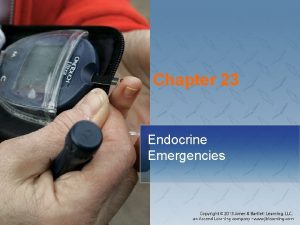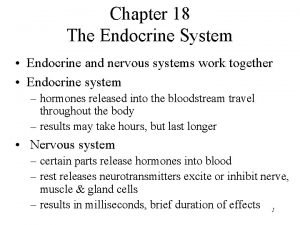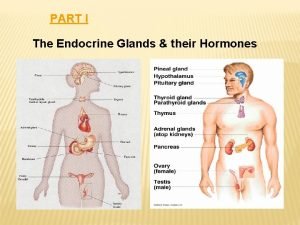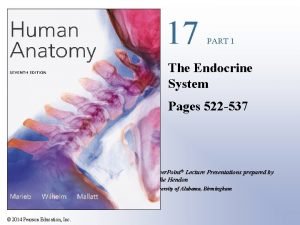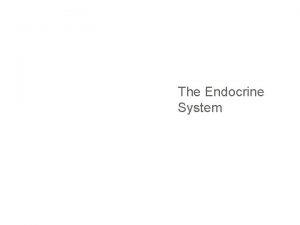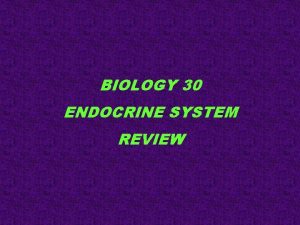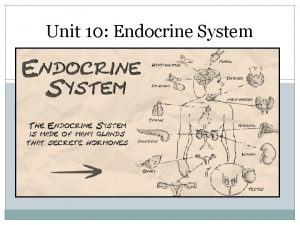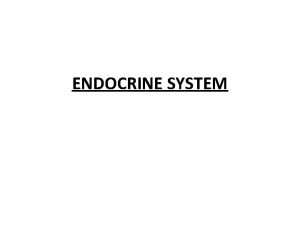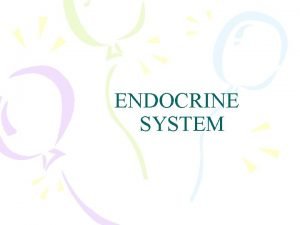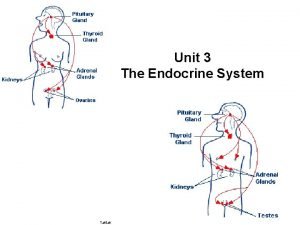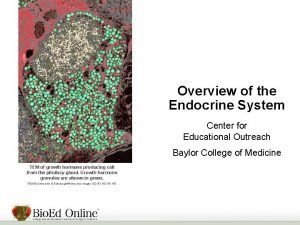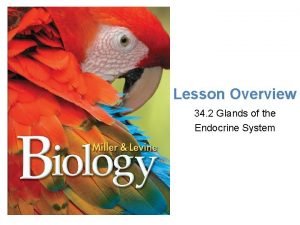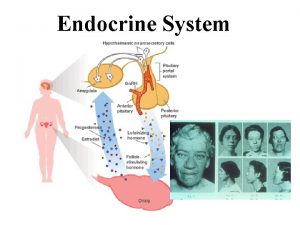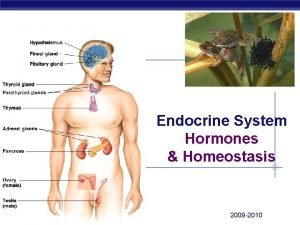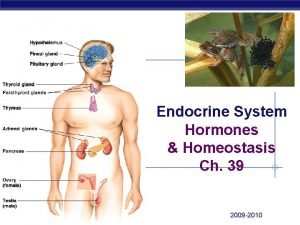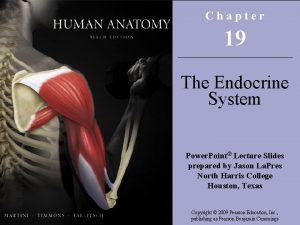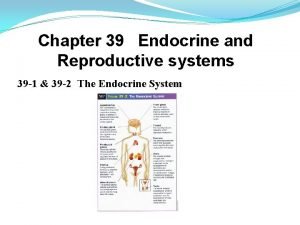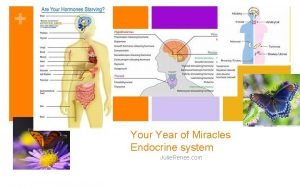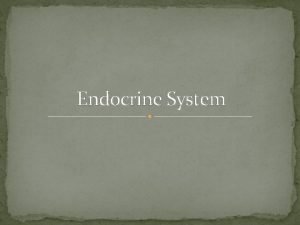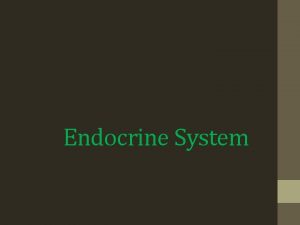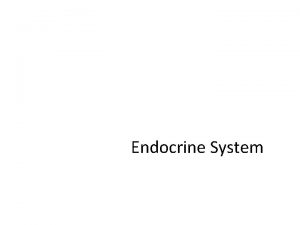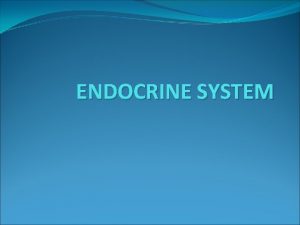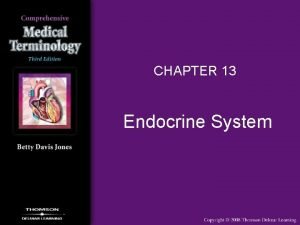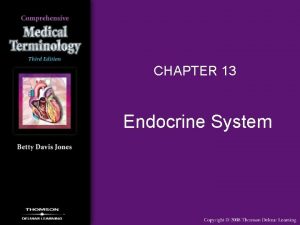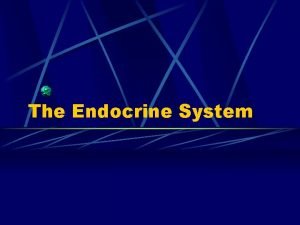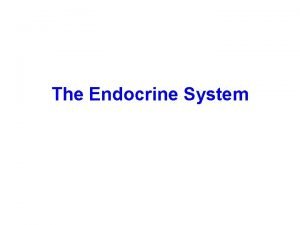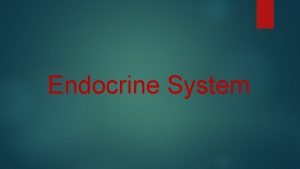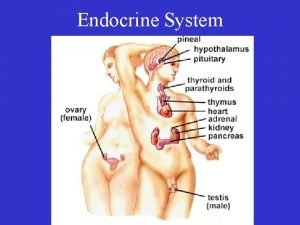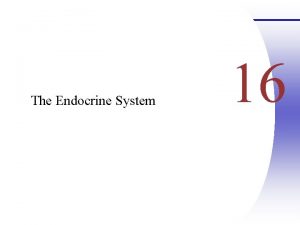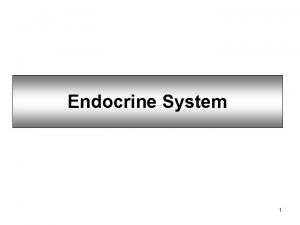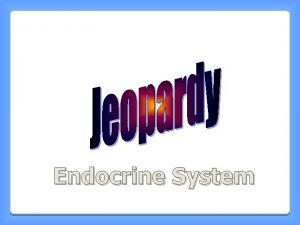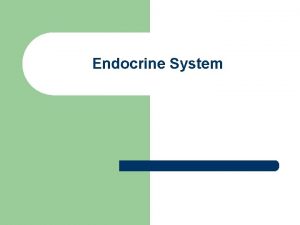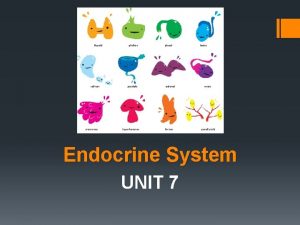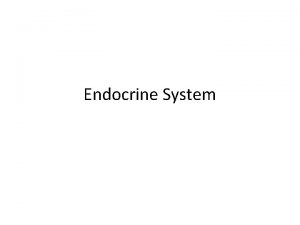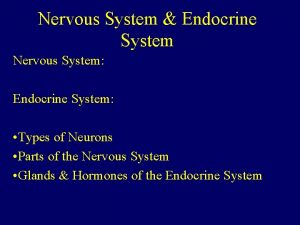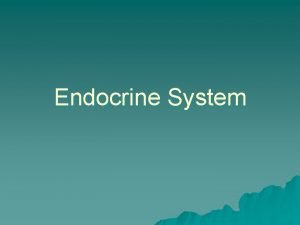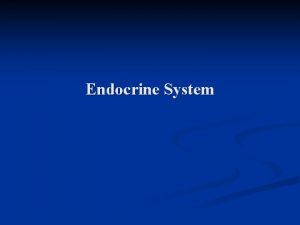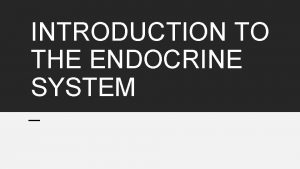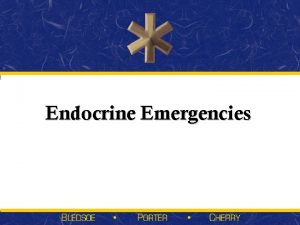Chapter 17 The Endocrine System 17 1 Ch

























































- Slides: 57

Chapter 17– The Endocrine System 17 -1

Ch. 17 Endocrine-- Study Guide 1. Critically read – pp. 638 -658 before “Hormones and Their Actions” section – pp. 668 -677 “Endocrine Disorder” section 2. Do Before You Go On and Think About It questions in the textbook 3. Do Testing Your Recall— 1 -4, 6, 8, 11, 13, 15 -18 4. Do True or False– 1, 3 -10 5. Do Testing Your Comprehension-- none 17 -2

17. 1. Overview of the Endocrine System 17 -3

Fig. 17. 1 -Endocrine glands 17 -4

§ Overview of Cell Communications • Necessary for integration of cell activities • Mechanisms – gap junctions • pores in cell membrane allow signaling chemicals to move from cell to cell; Example-- – Neurotransmitters (Fig. 17. 2 (a)) • released from neurons to travel across gap to 2 nd cell; Examples-- – Paracrine (local hormones) • secreted into tissue fluids to affect nearby cells – Hormones (strict definition) • chemical messengers that travel in the bloodstream. . . 17 -5

Figure 17. 2 a– A neuron has a long fiber that delivers its neurotransmitter. 17 -6

§ Endocrine System Components • Endocrine system – endocrine organs (thyroid, pineal, etc) – hormone producing cells in organs (brain, heart and small intestine) • Endocrine glands – produce hormones • Hormone – chemical messenger secreted into bloodstream, stimulates response in another tissue or organ (Fig. 17. 2 b); How? • Target cells – have receptors for a specific hormone 17 -7

Figure 17. 2 b– Endocrine cells secrete a hormone into the bloodstream. 17 -8

§ Comparison of Nervous & Endocrine Systems I (major differences) 1. Communication – nervous sys. - both electrical and chemical – endocrine sys. 2. Speed and persistence of response – nervous sys. - reacts quickly (1 - 10 msec), stops quickly – endocrine sys. 3. Adaptation to long-term stimuli – nervous sys. - response declines (adapts quickly) – endocrine sys. - response persists 17 -9

§ Comparison of Nervous & Endocrine Systems II (Similarities) 1. Several chemicals function as both hormones and neurotransmitters – NE and ADH 2. Some hormones secreted by neuroendocrine cells (neurons) – oxytocin 3. Both systems with overlapping effects on same target cells – NE and glucagon cause glycogen hydrolysis in liver 4. Systems regulate each other – neurons trigger hormone secretion – hormones stimulate or inhibit neurons 17 -10

§ Endocrine vs. Exocrine Glands • Exocrine glands – ducts carry secretion to a surface or organ cavity – extracellular effects (food digestion) – Example-- • Endocrine glands – no ducts; – intracellular effects, alter target cell metabolism – Example 17 -11

17. 2 A. The Hypothalamus and Pituitary Gland 17 -12

§ Hypothalamus • Shaped like a flattened funnel, forms floor and walls of third ventricle (Fig. 14. 12 b) • Regulates primitive functions from water balance, sex drive, . . . • Regulate many functions carried out by pituitary gland 17 -13

Pineal gland Pituitary gland (b) Hypothalamus Hypothalamic Nuclei Anterior nucleus Thirst; thermoregulation Arcuate nucleus Regulates appetite: secretes leaves hormones that releasing regulate anterior pituitary Dorsomedial nucleus Rage and other emotions Mammillary nuclei Relay between limbic system and thalamus; involved in longterm memory Paraventricular nucleus Produces oxytocin (involved in childbirth, lactation, orgasm); controls posterior pituitary Posterior nucleus Functions with periaqueductal gray matter of midbrain in emotional, cardiovascular, and pain control Preoptic nucleus Hormonal control of reproductive functions Suprachiasmatic nucleus Biological clock; regulates circadian rhythms and female reproductive cycle Supraoptic nucleus Produces antidiuretic hormone (involved in water balance); controls posterior pituitary Ventromedial nucleus Satiety center (suppresses hunger)

§ Pituitary Gland (Hypophysis) • Suspended from hypothalamus by stalk (infundibulum) • Location and size – housed in sella turcica of sphenoid bone – 1. 3 cm diameter • Adenohypophysis (____ pituitary) – arises from hypophyseal pouch (outgrowth of pharynx); Fig. 17. 3 • Neurohypophysis (____ pituitary) – arises from brain 17 -15

17 -16

§ Hypothalamic-hypophyseal portal system--1 1. (Anatomy)--Hypothalamic hormones travel in portal system from hypothalamus to anterior pituitary (Fig. 17. 4 and x) – Primary capillaries--? – Secondary capillaries--? 2. (Physiology) Hypothalamic hormones regulate hormones secretion by anterior pituitary • Example— Gonadotropin-releasing hormone (Gn. RH) and FSH/LH 17 -17

17 -18

Neurosecretory neurons Hypothalamus Hypophysiotropic H. : ●● 1 Systemic arterial inflow 2 Anterior pituitary Hypothalamic-hypophyseal portal system 3 System 6 venous outflow 4 Posterior pituitary 5 Anterior pituitary hormones: • 17 -19

§ Hypothalamic-hypophyseal portal system--2 3. Advantages (of this portal system)— • Almost all the blood supplied to the anterior pituitary must first pass through the _____________ • Releasing/inhibiting hormones then can directly deliver to the anterior pituitary in what fashion ? ______________ 17 -20

Check Point Questions-A. Besides hormones, give another way for intercellular communication. B. Give an example of a hormone. Why does your example qualify as a hormone? (hint: definition of hormone) C. Give an example of a hypothalamic hormone. D. What is the target tissue of a hypothalamic hormone secreted into the hypothalamic-hypophyseal portal system? 17 -21

§ Hormones secreted by anterior pituitary 1. FSH (follicle stimulating hormone) 2. LH (luteinizing hormone) The above two are called gonadotropins 3. TSH (thyroid stimulating hormone) 4. ACTH (adrenocorticotropic hormone) 5. GH (growth hormone) 6. PRL (prolactin) • Tropic hormones-- target other endocrine glands to release their own hormones; which ones above? (Fig. 17. 6) 17 -22

3. 2. 1. 17 -23

§ The Posterior Pituitary 17 -24

§ Posterior Pituitary Hormones • OT (oxytocin) and ADH – produced in hypothalamus – transported by hypothalamohypophyseal tract to posterior lobe (stores/releases hormones) 17 -25

Hormone Actions: Posterior Lobe • ADH (Antidiuretic Hormone) – Target organ/tissue-- ? • water retention, reduce urine – also functions as neurotransmitter • Oxytocin – labor contractions, lactation (milk ejection) – possible role in • sperm transport. . . • emotional bonding • Table 17. 4 on p. 645 is important 17 -26

Regulation of Posterior Pituitary • Posterior lobe control - neuroendocrine reflexes – hormone release in response to nervous system signals • suckling infant stimulates nerve endings hypothalamus posterior lobe oxytocin milk ejection – hormone release in response to higher brain centers • milk ejection reflex can be triggered by a baby's cry 17 -27

17. 2 B. Control of Pituitary Secretion 17 -28

§ Negative feedback 1. Principle– Def. The body senses a change and activates mechanisms that negate it; • (On pituitary hormones) target organ hormone levels inhibits release of tropic hormones 2. Example– TRH-TSH-thyroid hormones (see next slide; Fig. 17. 7) 17 -29


§ Positive feedback— 1 1. Definition– change in a factor triggers a physiological response that AMPLIFIES an initial change 2. Example— in the birth of a baby; how? Fig. 1. 12 17 -31

17 -32

§ Positive feedback— 2 3. Details of birth of a baby – 1. Uterine contractions push the fetus against the cervix – 2. The stretching of the cervix (RECEPTOR/SENSOR is the nerve cells here) triggers nerve impulses to the brain – 3. Brings about oxytocin secretion – 4. The hormone oxytocin causes even STRONGER powerful contractions of the uterus (EFFECTOR is muscles in wall of uterus) 17 -33

17. 3. Other Endocrine Glands 17 -34

§ A--Pineal Gland I. Where is it? II. Peak secretion ages 1 -5; by puberty 75% lower III. Produces serotonin by day, converts it to _____ at night IV. May regulate timing of puberty in humans V. Melatonin in SAD; by phototherapy – Symptoms of SAD: depression. . . – More SAD patients in Alaska or Florida? – Premenstrual syndrome (PMS) similar to SAD 17 -35

§ B--Thymus I. Location-mediastinum, II. Involution after puberty III. Its hormones-thymopoietin and thymosins; IV. Functions– on Tlymphocytes 17 -36

§ C--Thyroid Gland-1 I. Largest endocrine gland; high rate of blood flow II. Location-Anterior and lateral sides of trachea Fig. 17. 9 a 17 -37

Thyroid Gland-2 III. Histology— A. Thyroid follicles (Fig. 17. 9, Fig. x ) – Filled with colloid and lined with simple cuboidal epithelial (follicular cells) that secretes two thyroid hormones (TH), • Triiodothyronine Thyroxine – Control of TH secretion is in response to another hormone from the pituitary called ______ 17 -38

17 -39

17 -40

Thyroid Gland--3 IV. Functions of thyroid hormone A. or ↓ (circle one) body’s metabolic rate and O 2 consumption B. Calorigenic effect – C. or ↓ (circle one) heart rate and contraction strength D. respiratory rate E. stimulates appetite and breakdown CHO, lipids for fuel 17 -41

Thyroid Gland--4 V. C (calcitonin or parafollicular) cells A. Where are they located? Fig. x B. Produce _____ C. Target organ--? D. Function-- blood Ca 2+, promotes Ca 2+ deposition and bone formation especially in children – Osteoblasts more active – Osteoclasts are inhibited 17 -42

17 -43

17 -44

§ D--Parathyroid Glands--1 I. Location— II. Secretion— parathyroid hormone (PTH) III. Target organs--? 17 -45

§ Parathyroid Glands--2 IV. Functions of PTH-– or ↓ (circle one) blood Ca 2+ levels – promotes synthesis of calcitriol which: • +/-- absorption of Ca 2+ • +/-- urinary excretion • +/-- resorption of bone matrix 17 -46

§ E— The Pancreas-1 I. Location— in relation to the stomach (Fig. 17. 12 a-b, Fig. x) II. Endocrine secretion— by pancreatic islets – – Only constitute about ____ of the pancreas Including insulin, glucagon, and somatostatin Which one is hyperglycemic hormone and which one is hypoglycermic hormone? 98% is exocrine digestive gland 17 -47

17 -48

1 2 17 -49

17 -50

§ E— The Pancreas-2 III. Endocrine secretion— A. Insulin– secreted by beta cells; in response to rises of glucose and amino acids • • • Effects of insulin– promoting glycogen, fat, and protein synthesis Enhances cell growth and differentiation B. Glucagon— secreted by alpha cells; in response to concentration falls of blood glucose • • • Effects of glucagon— In the liver– gluconeogenesis, glycogenolysis In adipose tissue—fat catabolism, release fatty acids 17 -51

17. 7. Endocrine Disorders 17 -52

§ Endocrine Disorders • Hyposecretion – inadequate hormone release – Causes--tumor or lesion destroys gland • Ex--head trauma affects pituitary gland’s ability to secrete ADH (hyposecretion) – Results-- diabetes insipidus (tasteless in urine) • Hypersecretion – excessive hormone release – Causes--tumors or autoimmune disorder • Ex—autoantibodies mimic effect of TSH on the thyroid-- toxic goiter (graves disease) – Results– High TH in the blood; elevated metabolic/heart rate etc. 17 -53

§ Pituitary Disorders • Hypersecretion of growth hormones – Acromegaly– In adults; thickening of the bones and soft tissues – problems in childhood or adolescence • _____ if oversecretion • dwarfism if hyposecretion Which disease did she have? 17 -54

§ Diabetes mellitus-1 I. Causes– hyposecretion or inaction of insulin II. Symptoms– including three polys: – Polyurea – Polydipsia – Polyphagia – Hyperglycemia – Glycosuria – Ketonuria 17 -55

§ Diabetes mellitus-2 III. Type I (10%)– Insulin-dependent diabetes mellitus; juvenile diabetes – – Cause– the destruction of beta cells by autoantibodies Treatment– meal planning, exercise, the self -monitoring of blood glucose level, periodic insulin injections (or delivery by a pump) 17 -56

§ Diabetes mellitus-2 IV. Type II (90%)– Non-insulin-dependent diabetes mellitus; Adult-onset DM – – – Cause– Insulin resistance; Three major risk factors- heredity, age, and obesity Treatment– weight-loss program of diet and exercise, oral medications 17 -57
 Endocrine system and reproductive system
Endocrine system and reproductive system Endocrine system vs nervous system
Endocrine system vs nervous system Lymphatic system vs endocrine system
Lymphatic system vs endocrine system Amino acid-based hormones
Amino acid-based hormones Endocrine system
Endocrine system Endocrine
Endocrine Calcitonin and pth are antagonistic hormones
Calcitonin and pth are antagonistic hormones Chapter 7:13 endocrine system
Chapter 7:13 endocrine system Chapter 11 endocrine system
Chapter 11 endocrine system Pituitary
Pituitary Chapter 16 lesson 1 the endocrine system
Chapter 16 lesson 1 the endocrine system Chapter 45 hormones and the endocrine system
Chapter 45 hormones and the endocrine system Lipid soluble hormones examples
Lipid soluble hormones examples Parts of the endocrine system
Parts of the endocrine system Differences between nervous system and endocrine
Differences between nervous system and endocrine Comparison of endocrine and nervous system
Comparison of endocrine and nervous system Steroids endocrine system
Steroids endocrine system Endocrine system fact
Endocrine system fact Endocrine system of rat
Endocrine system of rat Pearson
Pearson Endocrine and nervous system comparison
Endocrine and nervous system comparison Stimulus endocrine system
Stimulus endocrine system Stimulus humoral
Stimulus humoral Biology 30 endocrine system
Biology 30 endocrine system Chromaffin cells
Chromaffin cells Endocrine system analogy
Endocrine system analogy Introduction of endocrine system
Introduction of endocrine system Endocrine system abbreviations
Endocrine system abbreviations T4.taktak
T4.taktak Endocrine glands
Endocrine glands Classification of hormone
Classification of hormone Pancreas in endocrine system
Pancreas in endocrine system Endocrine glands
Endocrine glands Endocrine system
Endocrine system Endocrine system regents questions
Endocrine system regents questions Endocrine system regents questions
Endocrine system regents questions Pearson endocrine system
Pearson endocrine system Chapter 46 digestive and endocrine disorders
Chapter 46 digestive and endocrine disorders Section 39-4 fertilization and development
Section 39-4 fertilization and development Chapter 29 endocrine and metabolic disorders
Chapter 29 endocrine and metabolic disorders Endocrine and hematologic emergencies
Endocrine and hematologic emergencies Your year of miracles
Your year of miracles Hát kết hợp bộ gõ cơ thể
Hát kết hợp bộ gõ cơ thể Lp html
Lp html Bổ thể
Bổ thể Tỉ lệ cơ thể trẻ em
Tỉ lệ cơ thể trẻ em Voi kéo gỗ như thế nào
Voi kéo gỗ như thế nào Tư thế worm breton là gì
Tư thế worm breton là gì Chúa yêu trần thế alleluia
Chúa yêu trần thế alleluia Các môn thể thao bắt đầu bằng tiếng chạy
Các môn thể thao bắt đầu bằng tiếng chạy Thế nào là hệ số cao nhất
Thế nào là hệ số cao nhất Các châu lục và đại dương trên thế giới
Các châu lục và đại dương trên thế giới Công thức tiính động năng
Công thức tiính động năng Trời xanh đây là của chúng ta thể thơ
Trời xanh đây là của chúng ta thể thơ Cách giải mật thư tọa độ
Cách giải mật thư tọa độ Làm thế nào để 102-1=99
Làm thế nào để 102-1=99 độ dài liên kết
độ dài liên kết Các châu lục và đại dương trên thế giới
Các châu lục và đại dương trên thế giới









